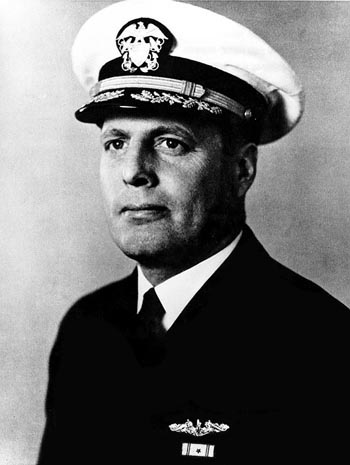John Cromwell was born on September 11, 1901, in Henry, Illinois. He entered the U.S. Naval Academy in June 1920, and graduated in June 1924. He served aboard the battleship USS Maryland (BB-46) and was commissioned an Ensign in 1925. Cromwell attended submarine school in 1926 and served aboard the submarine USS S-24 (SS-129) from 1927 to 1929. He attended diesel engineering school and served aboard several other submarines before commanding the submarine USS S-20 (SS-125) from 1936 to 1937. Cromwell then served on the staff of the Commander of Submarine Division 4 before serving with the Bureau of Engineering and Bureau of Ships in Washington, D.C., from 1939 to 1941. He became engineering officer for the Pacific Fleet submarine force in May 1941, and then commanded Submarine Divisions 203, 44, and 43. Capt Cromwell went to sea aboard USS Sculpin in late 1943, and went down with the ship after it was attacked on November 19, 1943. He was posthumously awarded the Medal of Honor for this action.
His Medal of Honor Citation reads:
For conspicuous gallantry and intrepidity at the risk of his life above and beyond the call of duty as Commander of a Submarine Coordinated Attack Group with Flag in the U.S.S. Sculpin, during the Ninth War Patrol of that vessel in enemy-controlled waters off Truk Island, November 19, 1943. Undertaking this patrol prior to the launching of our first large-scale offensive in the Pacific, Captain Cromwell, alone of the entire Task Group, possessed secret intelligence information of our submarine strategy and tactics, scheduled Fleet movements and specific attack plans. Constantly vigilant and precise in carrying out his secret orders, he moved his underseas flotilla inexorably forward despite savage opposition and established a line of submarines to southeastward of the main Japanese stronghold at Truk. Cool and undaunted as the submarine, rocked and battered by Japanese depth-charges, sustained terrific battle damage and sank to an excessive depth, he authorized the Sculpin to surface and engage the enemy in a gun-fight, thereby providing an opportunity for the crew to abandon ship. Determined to sacrifice himself rather than risk capture and subsequent danger of revealing plans under Japanese torture or use of drugs, he stoically remained aboard the mortally wounded vessel as she plunged to her death. Preserving the security of his mission at the cost of his own life, he had served his country as he had served the Navy, with deep integrity and an uncompromising devotion to duty. His great moral courage in the face of certain death adds new luster to the traditions of the United States Naval Service. He gallantly gave his life for his country.
|



